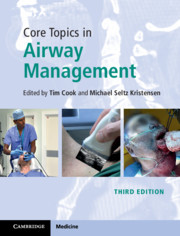Book contents
- Core Topics in Airway Management
- Core Topics in Airway Management
- Copyright page
- Contents
- Contributors
- Foreword
- Preface to the Third Edition
- Section 1 Airway Management: Background and Techniques
- Chapter 1 Anatomy
- Chapter 2 Physiology of Apnoea, Hypoxia and Airway Reflexes
- Chapter 3 The Epidemiology of Airway Management Complications
- Chapter 4 Structured Planning of Airway Management
- Chapter 5 Pre-anaesthetic Airway Assessment
- Chapter 6 Pre-anaesthetic Airway Endoscopy, Real and Virtual
- Chapter 7 Ultrasonography for Airway Management
- Chapter 8 Oxygenation: before, during and after Airway Management
- Chapter 9 Awake Tracheal Intubation
- Chapter 10 Drugs for Airway Management
- Chapter 11 How to Avoid Morbidity from Aspiration of Gastric Content to the Lungs
- Chapter 12 Face Mask Ventilation
- Chapter 13 Supraglottic Airways
- Chapter 14 Tracheal Intubation: Direct Laryngoscopy
- Chapter 15 Tracheal Tube Introducers (Bougies), Stylets and Airway Exchange Catheters
- Chapter 16 Tracheal Intubation Using the Flexible Optical Bronchoscope
- Chapter 17 Videolaryngoscopy
- Chapter 18 Expiratory Ventilation Assistance and Ventilation through Narrow Tubes
- Chapter 19 Multimodal Techniques for Airway Management
- Chapter 20 Front of Neck Airway (FONA)
- Chapter 21 Extubation
- Section 2 Airway Management: Clinical Settings and Subspecialties
- Section 3 Airway Management: Organisation
- Index
- References
Chapter 4 - Structured Planning of Airway Management
from Section 1 - Airway Management: Background and Techniques
Published online by Cambridge University Press: 03 October 2020
- Core Topics in Airway Management
- Core Topics in Airway Management
- Copyright page
- Contents
- Contributors
- Foreword
- Preface to the Third Edition
- Section 1 Airway Management: Background and Techniques
- Chapter 1 Anatomy
- Chapter 2 Physiology of Apnoea, Hypoxia and Airway Reflexes
- Chapter 3 The Epidemiology of Airway Management Complications
- Chapter 4 Structured Planning of Airway Management
- Chapter 5 Pre-anaesthetic Airway Assessment
- Chapter 6 Pre-anaesthetic Airway Endoscopy, Real and Virtual
- Chapter 7 Ultrasonography for Airway Management
- Chapter 8 Oxygenation: before, during and after Airway Management
- Chapter 9 Awake Tracheal Intubation
- Chapter 10 Drugs for Airway Management
- Chapter 11 How to Avoid Morbidity from Aspiration of Gastric Content to the Lungs
- Chapter 12 Face Mask Ventilation
- Chapter 13 Supraglottic Airways
- Chapter 14 Tracheal Intubation: Direct Laryngoscopy
- Chapter 15 Tracheal Tube Introducers (Bougies), Stylets and Airway Exchange Catheters
- Chapter 16 Tracheal Intubation Using the Flexible Optical Bronchoscope
- Chapter 17 Videolaryngoscopy
- Chapter 18 Expiratory Ventilation Assistance and Ventilation through Narrow Tubes
- Chapter 19 Multimodal Techniques for Airway Management
- Chapter 20 Front of Neck Airway (FONA)
- Chapter 21 Extubation
- Section 2 Airway Management: Clinical Settings and Subspecialties
- Section 3 Airway Management: Organisation
- Index
- References
Summary
When airway management is indicated, to avoid a bad outcome, patient safety will be maximised by careful decision making about and careful implementation of the chosen approach. This chapter addresses planning for the safest approach to securing the airway by assessing the patient for anatomical and physiological predictors of difficulty with airway management. When such difficulty is predicted, awake tracheal intubation will often provide the best margin of safety; indications for the procedure are discussed. Equally, when technical difficulty is predicted, the pre-conditions required to safely proceed with airway management after the induction of general anaesthesia are addressed. Predicted or not, difficulty encountered with tracheal intubation or supraglottic airway use in the unconscious patient must be met with a methodical and stepwise approach. This includes calling for help, maintaining patient oxygenation and methodically proceeding from one device type or technique to another, thus avoiding multiple futile attempts with the same device. Failure of a maximum of three attempts at the intended technique (most often tracheal intubation or use of a supraglottic airway) should be taken as an indication to refrain from further attempts, call for help, maintain patient oxygenation and reassess the plan for next steps. Finally, a ‘cannot intubate, cannot oxygenate’ situation is defined by the failure to successfully oxygenate the patient with all of tracheal intubation, face mask ventilation or a supraglottic airway and requires prompt front of neck airway access (‘surgical airway’).
Keywords
- Type
- Chapter
- Information
- Core Topics in Airway Management , pp. 38 - 49Publisher: Cambridge University PressPrint publication year: 2020

